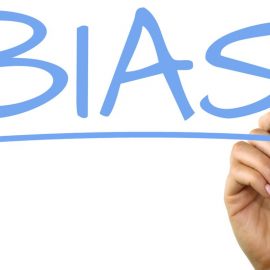
What role did language play in the emergence of human consciousness? How did metaphorical thinking transform our ancestors’ cognitive abilities?
Julian Jaynes proposes that consciousness developed not through biological evolution but through cultural changes driven by language. He argues that consciousness and language are deeply intertwined, with metaphors allowing humans to express abstract concepts and develop self-awareness.
Read on to explore Jaynes’s theory about how our minds evolved from hearing divine voices to developing rich inner lives.
Consciousness and Language
Jaynes contends that the complexity of the social world led to the emergence of consciousness. But importantly, he maintains that this shift was driven by culture rather than biology. While scientists have traditionally considered consciousness a result of natural selection, Jaynes disagrees. He argues the development of consciousness might have been aided by natural selection since consciousness made people more adaptable, less impulsive, and better able to learn new decision-making skills—all useful traits for survival. However, he believes consciousness was primarily learned through language—a cultural shift that created an intricate relationship between consciousness and language that allowed people to experience and express an interior life and to narrate and remember their experiences—a key part of our sense of self.
Jaynes explains that consciousness is based on language. As our ancestors developed the ability to use language, they learned to express their thoughts and emotions. So, language gave them a more self-reflective and self-aware way of experiencing the world. As a result, humans developed consciousness gradually, likely over centuries. Jaynes thinks the changes may have occurred at different times in different parts of the world. He argues the shift occurred earlier in Mesopotamia than in Mesoamerica (which spans present-day Mexico and Central America) because social conditions in Mesopotamia provided the right circumstances for a new mentality to replace the old one.
The Role of Metaphorical Language
One crucial tool in this cultural development was metaphorical language, where words and expressions generate mental images in the mind (like, for example, describing a challenge as an uphill climb). Such language helped people to understand and express abstract ideas. Jaynes proposes that as language evolves and becomes more complex, so does consciousness. As humans began using language to express abstract concepts and metaphorical ideas, their consciousness evolved to interpret and internalize these linguistic constructs. In other words, Jaynes contends that consciousness emerged from our ability to create metaphors to represent and understand the world.
The shift from concrete to abstract thinking through metaphorical language marked a significant step forward in human cognitive development and contributed to the emergence of other crucial elements of consciousness.
(Shortform note: While Jaynes focuses on how metaphorical language helped us develop abstract thought, some cognitive scientists suggest metaphors are more than just linguistic devices and might actually influence how we think about reality. According to the theory of embodied cognition, metaphors help us reason about abstract ideas by mapping these ideas onto familiar experiences we relate to physically—like by associating the feeling of affection with the sensory experience of warmth. Our brains process metaphorical statements automatically and directly, rather than first interpreting them literally. For that reason, some experts believe we need metaphors to think clearly: They make abstract ideas more concrete and understandable.)
Neurological Changes Supporting Consciousness
At the same time that people were developing consciousness and the cognitive tools it includes, the brain likely underwent changes that altered how it processed information and created our conscious experiences. Jaynes notes the brain gradually became more changeable and more adaptable. This new ability to change, which experts call neuroplasticity, enabled the brain to compensate for damage early in a person’s life by developing a different pathway to complete a cognitive task. As the brain became more resilient and better able to reorganize itself, it also became possible for different regions of the brain to work together on tasks like handling language or regulating emotion—which made it better able to adapt to new challenges.
Feedback Loops in Cognitive Development
Jaynes also points out that the mechanisms that enabled humans to develop consciousness likely interacted with each other in complex ways. The development of metaphorical language may have both enabled and been enabled by changes to the brain. Jaynes suggests these changes created a feedback loop, and each development enhanced the others. Consequently, humans gained a wide range of new abilities: to mentally simulate different scenarios for problem-solving and decision-making, to exercise more flexibility when responding to new or surprising situations, to think about others’ mental states, and even to lie to one another—a new skill enabled by the gap between inner experience and outer behavior.
(Shortform note: Some evolutionary psychologists agree with Jaynes that the evolution of human cognition was likely shaped by positive feedback loops. They think such loops existed between the development of technical skills, like tool-making, and the advancement of social skills, like cooperation, language, and culture. As societies became more complex and unstable, and people lost touch with what they’d perceived as the divine voices that Jaynes talks about, these changes would have accelerated the rate at which they developed more sophisticated cognitive abilities for dealing with the challenges they encountered.)
The Transformative Impact of Consciousness
The emergence of consciousness transformed the human experience. Jaynes explains that this new form of mental organization came with the ability to imagine a future and reflect on the remembered past. That brought with it thoughts of joy, terror, hope, and ambition. Humans gained the ability to look beyond immediate sensory recognition, engage in introspection, envision possibilities, and reflect on their emotions and memories. This gave them new ways of understanding time, language, and social interactions, and it led to the emergence of experiences like the ability to remember past experiences or think about one’s feelings.
Evidence Supporting Jaynes’s Theory
Jaynes cites several lines of evidence that he believes support his beliefs about how we evolved conscious awareness. A couple of them relate to language. In his book, he examines the development of words for mental states and consciousness in various languages, arguing that these concepts emerged relatively late. Also, he discusses the differences in function between the brain’s hemispheres, suggesting that the right hemisphere’s role in generating language could have been the source of the “voices” in the bicameral mind.
| The Contested Legacy of Julian Jaynes’s Consciousness Theory As Jaynes notes, the regions of the brain specialized for speech and language are typically located in the left hemisphere, making it the “dominant” half for most people. However, neuroscientists have since discovered that both hemispheres participate not only in understanding language, but also in making plans and decisions. Scientists now know the brain is much more “plastic” and adaptable than was assumed when Jaynes wrote his book, with regions able to take on new functions as needed. Subsequent discoveries about consciousness in animals have undermined some of Jaynes’s specific claims. Evidence shows that many animals—from crows and whales to octopuses and bees—display behaviors suggesting rudimentary consciousness, including tool use, deception, learning, memory, and social communication. These findings challenge Jaynes’s view that consciousness is uniquely human and emerged only recently. While Jaynes argues pre-conscious humans lacked introspective awareness, some experts place the emergence of self-awareness much earlier. Charles Foster writes in Being a Human that the Upper Paleolithic period, around 40,000 years ago, saw an explosion of symbolic thinking: People created representational art, developed metaphorical language, and showed evidence of understanding time differently. The appearance of human figurines and burial rituals suggests they had developed a concept of “self” distinct from others, enabling empathy, morality, and contemplation of existence—all capabilities Jaynes attributes to much later periods. Though Jaynes’s thesis is considered scientifically fringe, broader insights from his work—like the idea that language played a crucial part in pushing us toward consciousness—have influenced other thinkers. Experts ranging from philosopher Daniel Dennett (Darwin’s Dangerous Idea) to neuroscientist Antonio Damasio (Feeling & Knowing) have said they’re intrigued by Jaynes’s ideas. Dennett appreciates the distinction Jaynes proposes between human consciousness and animal consciousness and his idea that the difference might be rooted in the uniqueness of human language. Damasio agrees with Jaynes that accumulated knowledge could have altered human self-awareness and mental processing over time. |
Exercise: Consider Metaphorical Language and Consciousness
Jaynes suggests that metaphorical language helped humans develop consciousness by enabling abstract thought. Let’s examine how metaphors shape your own thinking.
- What metaphors do you commonly use to describe your mind or consciousness? (For example: “My mind is racing” or “I’m of two minds about this.”) List two or three.
- Pick one of these metaphors. How does this way of thinking about your mind influence how you understand and relate to your own thoughts?
- What’s a new metaphor you could use to think about your consciousness in a different way? How might this change your relationship with your thoughts?






